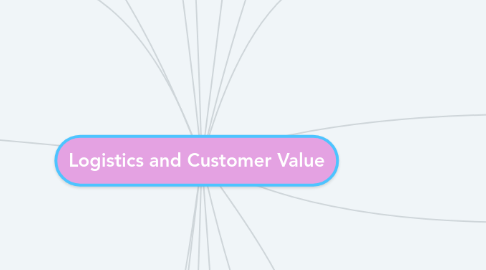
1. Fixed capital efficiency
2. 1. Identify the key components of customer service as seen by customers themselves. 2. Establish the relative importance of those service components to customers. 3. Identify ‘clusters’ according to similarity of service preferences.
3. 20% of customers buying 20% of the products = 4% of all customer/product transactions
3.1. Which provides: 80% of 80% of total profit = 64%
3.1.1. Just 4 per cent of transactions (measured order line by order line) gives us 64 per cent of all our profit!
4. Net operating income less Taxes less Working capital investment less Fixed capital investment = After-tax free cash flow
5. Is a true measure of what the business is worth to its shareholders
6. The bottom line determines the direction of the company and in some cases this has led to a limiting, and potentially dangerous, focus on the short term
7. Are generally supportive of the product while in use (Product warranty, parts and repair service, procedures for customer complaints and product replacement).
8. Market-driven supply chains
8.1. Low-cost producer
8.2. Customer-centric
8.2.1. Design the supply chain around the needs of the customer
8.2.1.1. This new perspective sees the consumer at the start of the supply chain
8.3. Linking customer value to supply chain strategy
8.3.1. Identify value segments
8.3.1.1. What do our customers value?
8.3.1.1.1. Needs vs Wants
8.3.2. Define the value proposition
8.3.2.1. How do we translate these requirements into an offer?
8.3.3. Identify the market winners
8.3.3.1. What does it take to succeed in this market?
8.3.4. Develop the supply chain strategy
8.3.4.1. How do we deliver against this proposition?
9. Customer service priorities
9.1. The ‘Pareto’ or 80/20 rule
9.1.1. The top 20% of products and customers by profitability are the ‘A’ category; the next 50% are labelled ‘B’; and the final 30% are category ‘C’.
9.2. Managing product service levels
9.2.1. Seek cost reduction
9.2.2. Provide high availability
9.2.3. Review
9.2.4. Centralised inventory
10. Service standards
11. Logistics and the bottom line
11.1. ROI = Profit ––––––––––––––––––– Capital employed
11.2. Logistics and shareholder value
11.2.1. what is the company worth to its owners?
11.2.2. Shareholder is determined by the net present value of future cash flows.
11.2.3. Economic Value Added (EVA)
11.2.3.1. Is the difference between operating income after taxes less the true cost of capital employed to generate those profits
11.2.4. Market Value Added (MVA)
11.3. The drivers of shareholder value
11.3.1. Revenue growth
11.3.2. Operating cost reduction
11.3.3. Working capital efficiency
11.3.4. Tax minimisation
12. · Order cycle time · Stock availability · Order-size constraints · Ordering convenience · Frequency of delivery · Delivery reliability · Documentation quality · Claims procedure · Order completeness · Technical support · Order status information
13. Customer Value
13.1. Perceptions of benefits –––––––––––––––––––––––– Total cost of ownership
13.2. Total cost of ownership: -Management -Operating -Inventory -Technical -Training -Etc
13.3. Quality Service Cost Time
13.3.1. Are you competitive?
14. Customer Service
14.1. Pre-transactions elements
14.1.1. Are relate to corporate policies or programmes
14.2. Transaction elements
14.2.1. Are those customer service variables directly involved in performing the physical distribution function
14.3. Post-transaction elements
15. Out-of-Stock
15.1. Having what you need every single time, so the consumer won't substitute the product
16. Customer service and customer retention
16.1. Service surround
16.2. How many of the customers that we had "x" months ago do we still have today?
16.2.1. An existing customer can provide a higher profit contribution and has the potential to grow in terms of the value and frequency of purchases than a new customer.
16.2.1.1. Lifetime value
16.2.1.1.1. If customers can be persuaded to remain loyal to a supplier, their lifetime value can be significantly increased.
16.2.2. In addition to the core product, these characteristics enter into the final value: • Quality • Product features • Technology • Durability, etc. • Delivery lead time and flexibility • Delivery reliability and consistency • Order fill • Ease of doing business • After-sales support, etc.
16.2.2.1. Average transaction value × Yearly frequency of purchase × Customer ‘life expectancy

